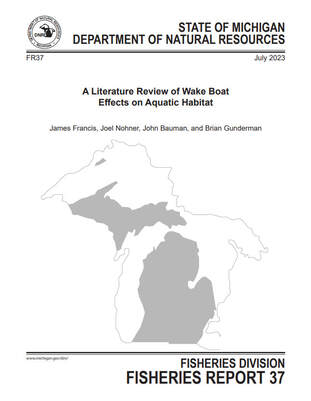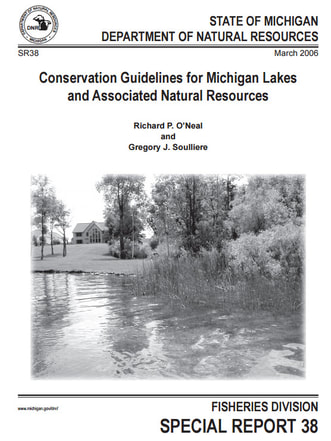Natural Shoreline Research
|
A Literature Review of Wake Boat Effects on Aquatic Habitat
Michigan Department of Natural Resources Fisheries Division Fisheries Report 37 The operation of wake boats in a manner that creates large waves can erode shorelines and resuspend sediments and is an emerging threat to natural resources in inland lakes. Wake boats can produce waves with 1.7–17 times the energy of other comparable-sized powerboats and their propellers generated enough turbulence to resuspend bottom sediments in water up to 33 feet deep. The large waves generated by wake boats take between 400–1,023 feet to dissipate to heights and wave energies observed 100–200 feet away from typical boats operating at cruising speed. Recommendations are provided in the document. |
|
Conservation Guidelines for Michigan Lakes and Associated Natural Resources
O'Neal and Soulliere Michigan Department of Natural Resources Fisheries Division Special Report 38 March 2006 The Michigan Department of Natural Resources, Fisheries and Wildlife divisions, have developed guidelines for protecting and restoring the natural resources of Michigan lakes. Descriptions of stresses and threats to lake ecology include the cumulative effects of small modifications to habitats, artificial drainage, water quality and pollutants, dams and lake-level control, non-indigenous species, shoreline development, dredging and filling bottomlands, vegetation alteration, swimmer’s itch control, and boating and shipping activities. The guidelines recommend a watershed approach for protection and management of ecosystem integrity and natural resources of lakes, with development of comprehensive resource assessments and management plans.
| |||
| |||
Status and Trends of Michigan Inland Lake Resources, 2002-2007
Michigan Department of Natural Resources
August 2015
This report represents the first statewide assessment of inland lake resources and is intended for use by scientists, managers, policy makers, and the public. It provides an up-to-date summary of information on lakes and characterizes the broad-scale patterns in lake habitat, fish community structure, and fish population dynamics. The findings presented here document the current status of selected lake resources and establish the baseline conditions against which future monitoring results can be compared.
Michigan Department of Natural Resources
August 2015
This report represents the first statewide assessment of inland lake resources and is intended for use by scientists, managers, policy makers, and the public. It provides an up-to-date summary of information on lakes and characterizes the broad-scale patterns in lake habitat, fish community structure, and fish population dynamics. The findings presented here document the current status of selected lake resources and establish the baseline conditions against which future monitoring results can be compared.
Cumulative Effects of Incremental Shoreline Habitat Modification on Fish Assemblages in North Temperate Lakes
Jennings, Bozek, Hatzenbeler, Emmons, Staggs
North American Journal of Fisheries Management 19:18-27, 1999
Abstract
Natural and Human Influences on Fish Species Richness in Small North Temperate Lakes: Implications for Bioassessment
Jennings, Hatzenbeler, Bozek, Edwards
Journal of Freshwater Ecology, Volume 24, Number 1 - March 2009
Abstract
Branching Complexity and Morphological Characteristics of Coarse Woody Structure as Lacustrine Fish Habitat
Newbrey, Bozek, Jennings, Cook
Can. J. Fish Aquat. Sci. 62: 2110-2123 (2005)
Abstract
Is Littoral Habitat Affected by Residential Development and Land Use in Watersheds of Wisconsin Lakes?
Jennings, Emmons, Hatzenbeler, Edwards, Bozek
Lake and Reservoir Management 19(3):272-279, 2003
Abstract
A Comparison of Fish and Aquatic Plant Assemblages to Assess Ecological Health of Small Wisconsin Lakes
Hatzenbeler, Kampa, Jennings, Emmons
Lake and Reservoir Management 20(3)211-216, 2004
Abstract
Jennings, Bozek, Hatzenbeler, Emmons, Staggs
North American Journal of Fisheries Management 19:18-27, 1999
Abstract
Natural and Human Influences on Fish Species Richness in Small North Temperate Lakes: Implications for Bioassessment
Jennings, Hatzenbeler, Bozek, Edwards
Journal of Freshwater Ecology, Volume 24, Number 1 - March 2009
Abstract
Branching Complexity and Morphological Characteristics of Coarse Woody Structure as Lacustrine Fish Habitat
Newbrey, Bozek, Jennings, Cook
Can. J. Fish Aquat. Sci. 62: 2110-2123 (2005)
Abstract
Is Littoral Habitat Affected by Residential Development and Land Use in Watersheds of Wisconsin Lakes?
Jennings, Emmons, Hatzenbeler, Edwards, Bozek
Lake and Reservoir Management 19(3):272-279, 2003
Abstract
A Comparison of Fish and Aquatic Plant Assemblages to Assess Ecological Health of Small Wisconsin Lakes
Hatzenbeler, Kampa, Jennings, Emmons
Lake and Reservoir Management 20(3)211-216, 2004
Abstract
|
Shoreline Hardening Alters Freshwater Shoreline Ecosystems
Wensink, Stacey and Scott Tiegs Department of Biological Sciences, Oakland University, Rochester, Michigan The Journal for Freshwater Science Volume 35, September 2016 |
| ||


